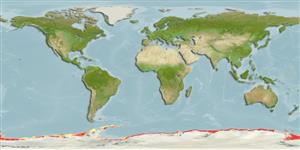>
Perciformes/Notothenioidei (Icefishes) >
Nototheniidae (Cod icefishes) > Trematominae
Etymology: Trematomus: Greek, trematos = hole + Greek, tomo = section, cut (Ref. 45335); lepidorhinus: lepidorhinus from Greek, lepido means scale; rhinus means snout (Ref. 11892).
Issue
The genus Pseudotrematomus is a synonym of Trematomus, which is confirmed by a molecular study to be published (J.-C. Hureau, pers. comm. 08 Jun. 2010).
Environment: milieu / climate zone / depth range / distribution range
Ecologia
marino batidemersale; distribuzione batimetrica 200 - 800 m. Deep-water; 60°S - 78°S, 180°W - 180°E
Southern Ocean: inner slope and continental shelf of Antarctica, except the Antarctic Peninsula. Two specimens are reported from South Orkney islands.
Size / Peso / Age
Maturity: Lm ? range ? - ? cm
Max length : 31.0 cm TL maschio/sesso non determinato; (Ref. 5179); peso massimo pubblicato: 276.30 g (Ref. 124149)
Spine dorsali (totale) : 6 - 7; Raggi dorsali molli (totale) : 31 - 33; Raggi anali molli: 34 - 36. Brownish with irregular indistinct darker crossbars, spinous dorsal blackish. Mouth and branchial cavities blackish (Ref. 11892).
Adults feed on amphipods (mostly Themisto gaudichaudii), copepods, polychaetes, and mysids.
Dewitt, H.H., P.C. Heemstra and O. Gon, 1990. Nototheniidae. p. 279-331. In O. Gon and P.C. Heemstra (eds.) Fishes of the Southern Ocean. J.L.B. Smith Institute of Ichthyology, Grahamstown, South Africa. (Ref. 5179)
IUCN Red List Status (Ref. 130435: Version 2024-1)
Threat to humans
Harmless
Human uses
Pesca: di nessun interesse
Strumenti
Special reports
Download XML
Fonti Internet
Estimates based on models
Preferred temperature (Ref.
123201): -1.8 - 1.1, mean -0.9 °C (based on 763 cells).
Phylogenetic diversity index (Ref.
82804): PD
50 = 0.5005 [Uniqueness, from 0.5 = low to 2.0 = high].
Bayesian length-weight: a=0.00427 (0.00285 - 0.00638), b=3.22 (3.10 - 3.34), in cm total length, based on LWR estimates for this species & Genus-body shape (Ref.
93245).
Trophic level (Ref.
69278): 3.8 ±0.2 se; based on diet studies.
Resilienza (Ref.
120179): Medio, tempo minimo di raddoppiamento della popolazione 1.4 - 4.4 anni (Fec = 2,200).
Fishing Vulnerability (Ref.
59153): High vulnerability (62 of 100).
Nutrients (Ref.
124155): Calcium = 24.9 [14.7, 63.2] mg/100g; Iron = 0.463 [0.191, 0.925] mg/100g; Protein = 17.2 [16.1, 18.3] %; Omega3 = 0.406 [0.222, 0.713] g/100g; Selenium = 14.9 [6.1, 36.2] μg/100g; VitaminA = 29.1 [6.2, 142.1] μg/100g; Zinc = 0.473 [0.306, 0.729] mg/100g (wet weight); based on
nutrient studies.
